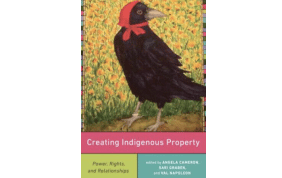Several times each month, we are pleased to republish a recent book review from the Canadian Law Library Review (CLLR). CLLR is the official journal of the Canadian Association of Law Libraries (CALL/ACBD), and its reviews cover both practice-oriented and academic publications related to the law.
Creating Indigenous Property: Power, Rights, and Relationships. Edited by Angela Cameron, Sari Graben & Val Napoleon. Toronto: University of Toronto Press, 2020. ix, 374 p. Includes table of contents and bibliographical references. ISBN 9781487505455 (hardcover) $100.00; ISBN 9781487523824 (softcover) $42.95; ISBN 9781487532130 (ePUB) $42.95; ISBN 9781487532116 (PDF) $42.95.
Reviewed by Tim Knight
Associate Librarian, Head of Technical Services
Osgoode Hall Law School, York University
In CLLR 47:2
From an Indigenous perspective, there exists a “spiritual connection between people and their land” (p. 61). The land is inalienable and life-giving, a “relation rather than an object of ownership” (p. 9). The land is something to be revered, cared for, and shared. The idea that “Indigenous property” is something that can be created caught my attention. There is a point where land becomes property. It is embedded in the Canadian colonial-settler view that sees land as something to own and exploit for personal gain by legally “individuated persons” (p. 32). However, difficulties will arise when work is carried out in a multi-juridical Canadian context filled with “overlapping legal orders” (p. 46) where Indigenous, civil, and common law attempt to coexist.
Val Napoleon and Emily Snyder, therefore, astutely observe that any form of property negotiations will be set within “unquestioned Western property constructs and ongoing colonial structures” (p. 41). The result, as Jamie Baxter puts it, becomes a “contest over the conceptual framing of Indigenous land rights as either private or public rights, as property versus territory—framings that today remain largely unstable” [emphasis in original] (p. 212). Shalene Jobin underlines this fundamental difference with this quote by Métis Elder Elmer Ghostkeeper, who characterizes this shift in perspective from “living with the land to living off the land” [emphasis in original] (p. 105).
In addition to a succinct preface and the editors’ introduction, there are 10 papers in this volume presented in four parts: Indigenous Law in Practice, Political Issues, Common Law’s Response, and Lessons from the Transnational Context. Four of the 16 contributors are Indigenous: Val Napoleon, also one of the editors of this collection, is Cree from Saulteaux First Nation and an adopted member of the Gitanyow (Gitxsan) nation; Shalene Jobin is a member of the Red Pheasant Cree First Nation; Sarah Morales is Coast Salish and a member of the Cowichan Tribes; and Karen Drake, who contributed the preface, is a citizen of the Métis Nation of Ontario. While it is true that these papers are written primarily by non-Indigenous authors, the collective scholarship, legal practices, and teaching experiences of all these contributors draw from wide-ranging perspectives on Indigenous law and legal issues and how these interact with settler colonialism and a “neoliberal economic agenda” (p. 95). The majority are written from a Canadian context except for the final two chapters, which provide a useful point of comparison describing Indigenous experiences with land and property in Nigeria and the Kingdom of Eswatini, respectively.
From a colonial perspective, there is a common belief that the ownership of land will “implant pride and produce profit” (p. 163), resulting in an overall positive benefit. However, Karen Drake cautions in her preface that a focus on outcomes will likely falter if the discussion is not built on a “shared set of norms” (p. viii). This outcome-based “policy paradigm” (p. 100) emerges from the same ideology that believes any form of collectivism will lead to tyranny (p. 166) and that the collective ownership of property will ultimately lead to poverty. This view purports that private property creates prosperity and therefore “any other alternative towards the integrity of the territory as well as Indigenous sovereignty and autonomy has no viability and is doomed” (p. 170). In other words, this position perpetuates and reinforces “colonial narratives about the inferiority of Indigenous peoples, their laws, and ideas regarding land and property ownership” (p. 43).
Historically, potential economic benefits don’t often favour Indigenous communities. As Shalene Jobin suggests, to achieve anything approaching economic prosperity, Indigenous communities must frequently arrive at decisions that “support a neoliberal economic agenda, compromising their Indigenous identities” (p. 95). For example, Sarah Carter and Nathalie Kermoal see making reserve land available for settlers to purchase as another way to “advance a neoliberal agenda” (p. 164) and leads to an erosion of Indigenous control of Indigenous land. Even when some gains appear to have been made, as Sari Graben and Christian Morey note regarding the definition of “Aboriginal title” (p. 287) in the recent Supreme Court of Canada decision in Tsilhqot’in Nation v British Columbia, the Crown retains the “potential for infringement … [if the] title lands can be used for large-scale infrastructure or resource development deemed to be in the public interest” (p. 302). But for whose “public,” and in whose “interest”?
As I continue to learn more about my own settler view of the world and how it relates to the worldviews of First Nations, Inuit, and Métis, I found this to be an engaging, well-written, and thoroughly researched collection of papers. And, while perhaps not a primary intention of the editors, this has turned out to be a surprisingly instructive resource for clarifying and understanding some of the “tensions” (p. 32) that exist between Indigenous and colonial worldviews. Since private property is a fundamental component of capitalism/colonialism, I would strongly recommend this collection as an important vehicle for developing a better understanding of how the “capitalist-exploitation logic” (p. 110) informs our relationships with Indigenous Peoples in this country. And if you do happen to have an interest in property rights and Indigenous legal issues, this will also be an indispensable addition to your collection.
Book Review: Creating Indigenous Property: Power, Rights, and Relationships




